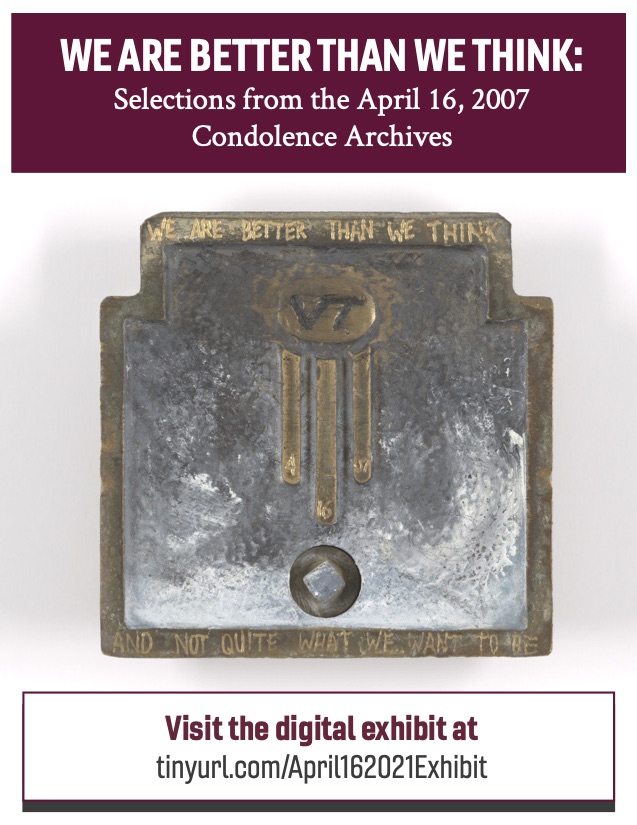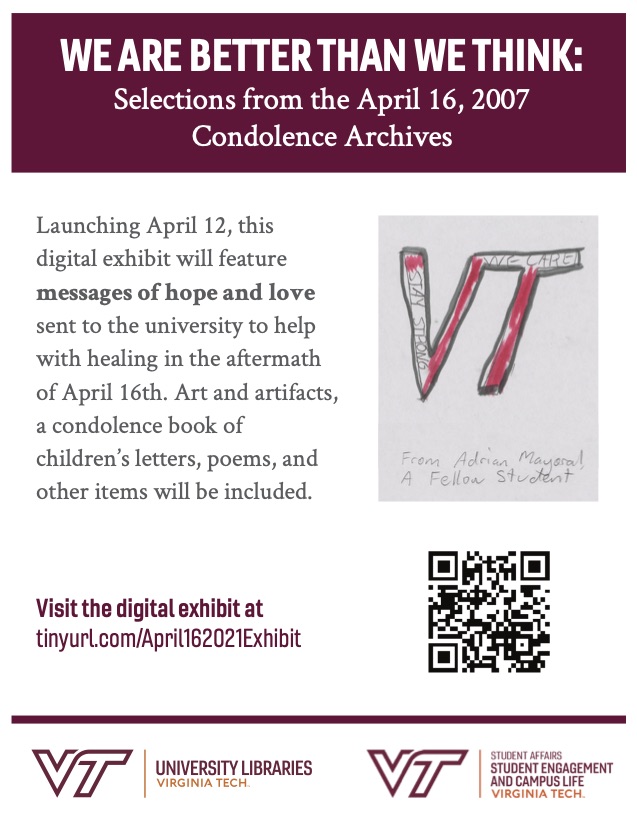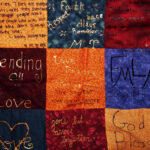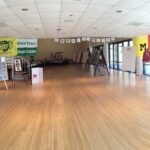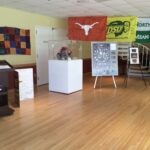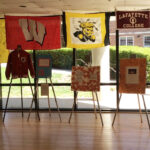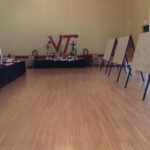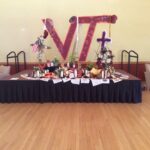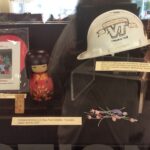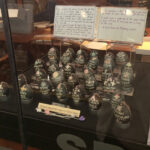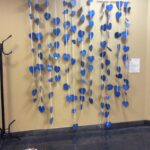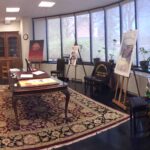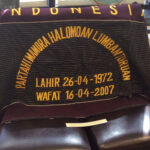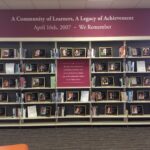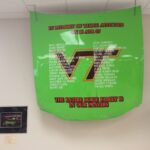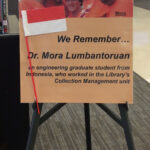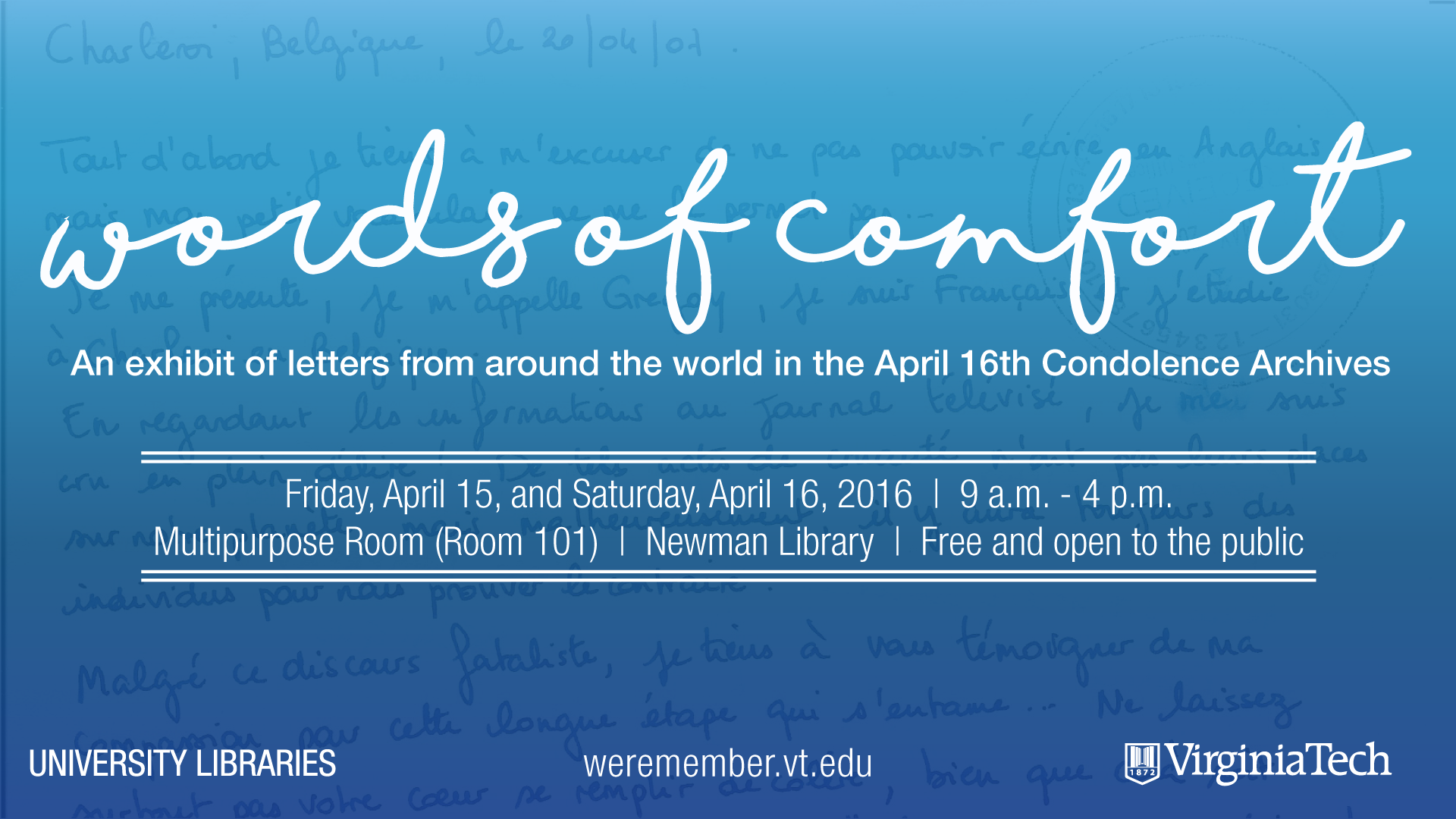|
We continue to remember the 32 victims: |
|
|
Ross A. Alameddine |
Liviu Librescu |
We Are Better Than We Think: April 16th remembrance exhibit online

Every year Special Collections and University Archives, in partnership with the University Libraries and Virginia Tech Student Engagement and Campus Life, hosts annual remembrance exhibits to highlight the outpouring of love and support the university received in the aftermath of the tragedy of April 16, 2007. Although we are unable to host substantial physical exhibits this year due to the Covid-19 pandemic, we have continued the remembrance exhibit online.
The exhibit We Are Better Than We Think: Selections from the April 16, 2007 Condolence Archives highlights the items Virginia Tech received following the events of April 16th. It features artifacts, children’s letters, poems, and more with messages of love, hope, and peace, most of which have not been displayed for exhibition before.
Visit the exhibit online at https://tinyurl.com/April162021Exhibit.
The title piece of the exhibit, “We Are Better Than We Think” by Eric W. Schuttler (pictured above) is on display in Newman Library near the 2nd floor entrance, April 12 thru April 23 during the library’s open hours. (No other items are on display.)
For more information on the university’s remembrance events, including the virtual 3.2-Mile Run in Remembrance, please visit https://www.weremember.vt.edu/.
Unknown Origin: April 16th remembrance exhibit online

Every year Special Collections and University Archives, in partnership with the University Libraries and Virginia Tech Student Engagement and Campus Life, hosts annual remembrance exhibits to highlight the outpouring of love and support the university received in the aftermath of the tragedy of April 16, 2007. Although we are unable to host physical exhibits this year due to the Covid-19 pandemic, we have continued the remembrance exhibit online.
The exhibit Unknown Origins: Anonymous gifts in the April 16, 2007 Condolence Archives highlights the messages Virginia Tech received from unknown individuals, organizations, or places following the events of April 16, 2007. It features anonymous donations and gifts of unknown origin, paying homage to those who want to be part of the mourning and recovery process but do not necessarily want to be known.
Visit the exhibit online at https://tinyurl.com/April16Exhibit.
For more information on the university’s remembrance events, including the virtual 3.2-Mile Run in Remembrance, please visit https://www.weremember.vt.edu/.
A Complete, Balanced Breakfast: Battle Creek, Cookery, and the Kellogg Legacy
This week, I put up a new exhibit titled “A Complete, Balanced Breakfast: Battle Creek, Cookery, and the Kellogg Legacy.” This idea has been on my board for months now, for better or worse, and I’ve finally had an opportunity to dive into it. There’s a fair bit I did not include about John Kellogg’s belief and medical practices to save visitors the sometimes weird or disturbing details, but there is plenty of reading out there for those interested. Given our penchant for food & drink history here at Special Collections and University Archives, it’s no surprise we might have some material on the Kelloggs and breakfast cereal. More than will fit in our display cases, as is often the case. So, there are two main parts to this story: The works of John and Ella Kellogg, which were largely instructive texts or published lectures and the history and advertising of the food companies that came from the Battle Creek legacy. If you can’t visit us in person, here’s a little virtual tour!
John and Ella Kellogg
John Harvey Kellogg (1852-1943) was born in Tyrone, Michigan in 1852. His family moved to Battle Creek in 1856. Raised as a Seventh-Day Adventist, the church shaped much of his early life, his medical education, and much of his medical career–in particular, the teachings of Ellen G. and James Springer White. In 1876, after graduating from the NYU Medical College at Bellevue Hospital, Kellogg returned to Battle Creek and took over the Western Health Reform Institute, which he renamed the Battle Creek Medical Surgical Sanitarium. There, he preached a vegetarian, caffeine/alcohol/tobacco-free diet, among his varied–and often controversial–practices and beliefs. Over the course of his life, he wrote more than 50 books and at least as many articles, pamphlets, and lectures detailing his views on health, nutrition, hygiene, sex, and raising families and children.
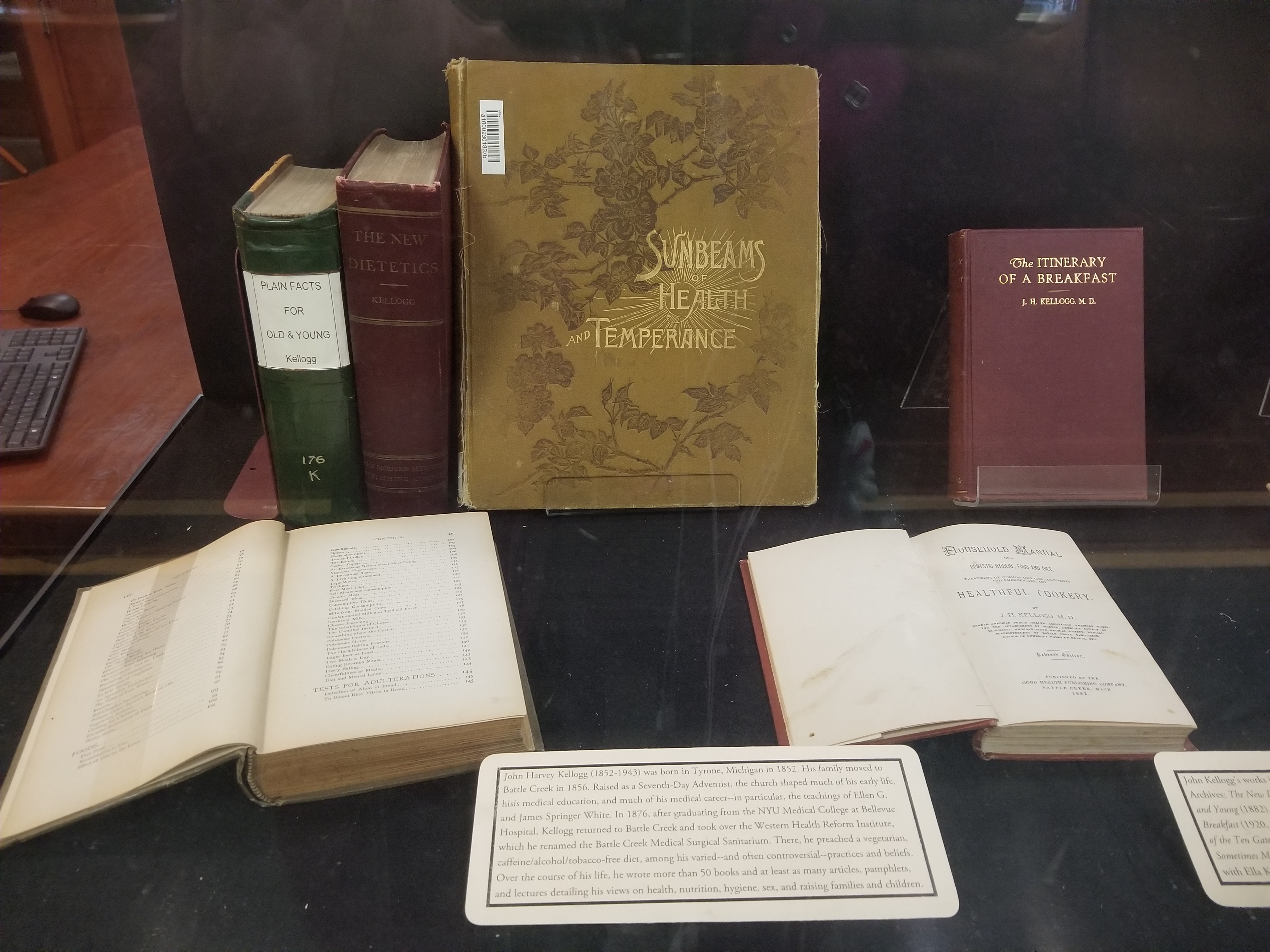
Ella Eaton (1853-1920) studied at Alfred University and with an interest in sanitation and hygiene, she enrolled at the Sanitarium School of Hygiene in Battle Creek in 1876, where she met John Harvey Kellogg. They married in 1879. Over the course of her lifetime, Ella would break ground in a variety of ways. She was an early founder of what we now consider the field of dietetics; she founded a cooking school and a school of home economics; she was a prolific book and article editor and author; at various times, she led organizations focused on childcare, motherhood, dietetics, hygiene, temperance, and social purity; she supported womens suffrage; and she helped raise more than 40 foster children, several of whom she and John formally adopted.
Her most well-know work was the 1892 Science in the Kitchen: A Scientific Treatise on Food Substances and Their Dietetic Properties, Together with a Practical Explanation of the Principles of Healthful Cookery, and a Large Number of Original, Palatable, and Wholesome Recipes (picture here in the front right).This extensive book was a reflection of her career and went through five editions by 1910. It was heavily illustrated and was Ellas essential guide to everything domestic. Special Collections and University Archives has two editions of this book available digitized and online (http://digitalsc.lib.vt.edu). In addition, we house copies of Healthful Cookery (1908), Every-Day Dishes and Every-Day Work (1896), and an 1893 edition of Science in the Kitchen.
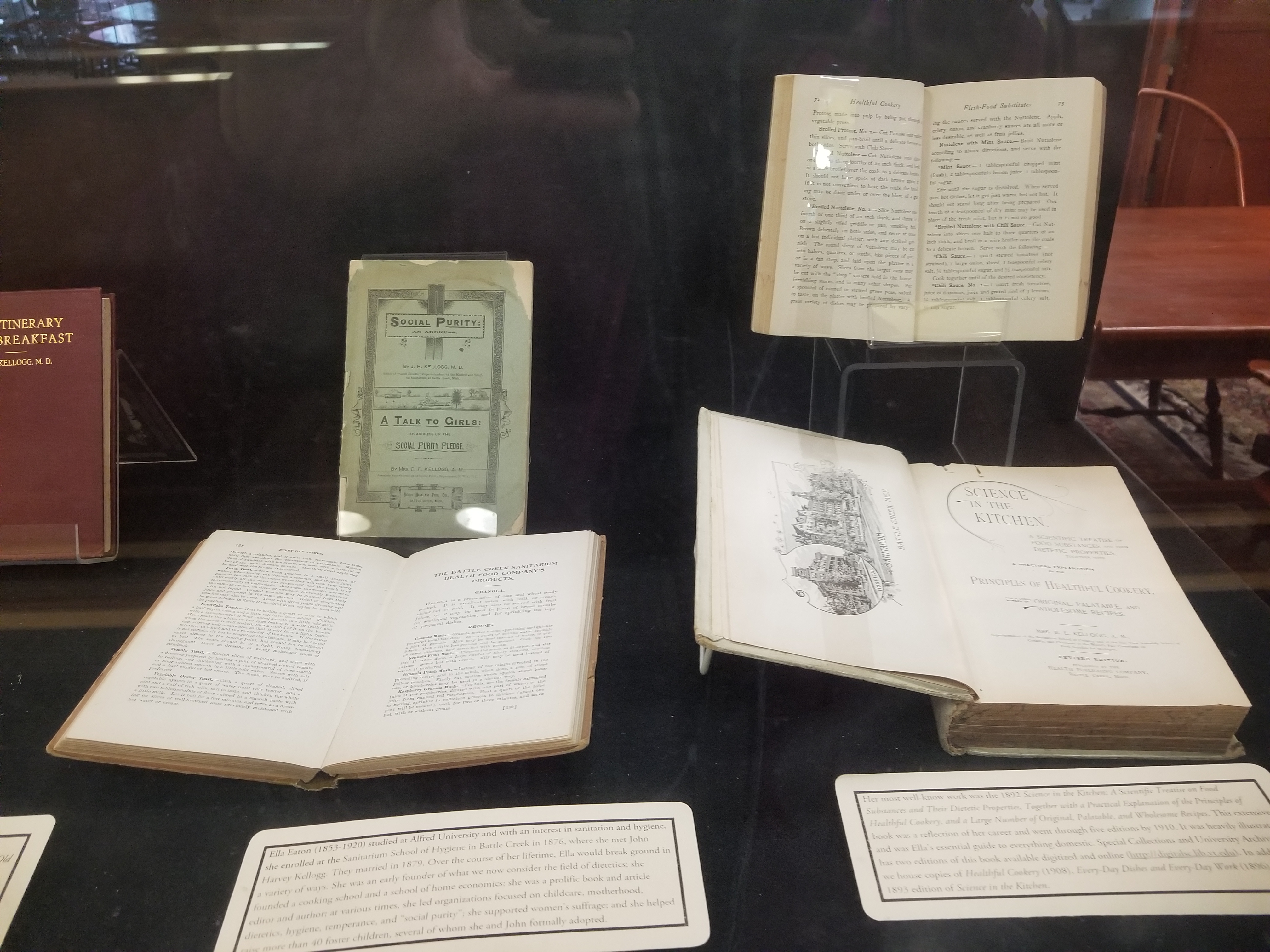
The Battle Creek Food Legacy
In 1897, brothers John and W. K. Kellogg founded their first food company, the Sanitas Nut Food Company (sometimes the Sanitas Food Company), which mainly sold nut butter-like products as a meat substitute. (John Kellogg is listed among those responsible for the creation of peanut butter precursors and he corresponded with George Washington Carver on the subject). In the mid-1890s, partially by accident, while working on their version of granola, they stumbled onto something else: wheat berry flakes. These flattened wheat berries would lead to–you guessed it–corn flakes! A patient at the Battle Creek Sanitarium, C. W. Post, witnessed the process for these products, and also jumped on board, launching the Postum Cereal Co. in 1895. Postum Cereal Co. made Grape-Nuts in 1897 and Post Toasties Double-Crisp Corn Flakes in 1904.
A disagreement between the two brothers led to a split. W. K. took the flakes and launched the Battle Creek Toasted Corn Flake Company in 1906 (renamed the Kellogg Toasted Corn Flake Company in 1909 and the Kellogg Company in 1922). The company would continue to develop new products based on the brothers’ work and teachings, with a particular emphasis on vegetarianism and meat substitutes. The company would also develop divisions with broader interests, like quantity cooking for schools, camps, and even the military. Advertising materials for children’s products were created to target that audience.
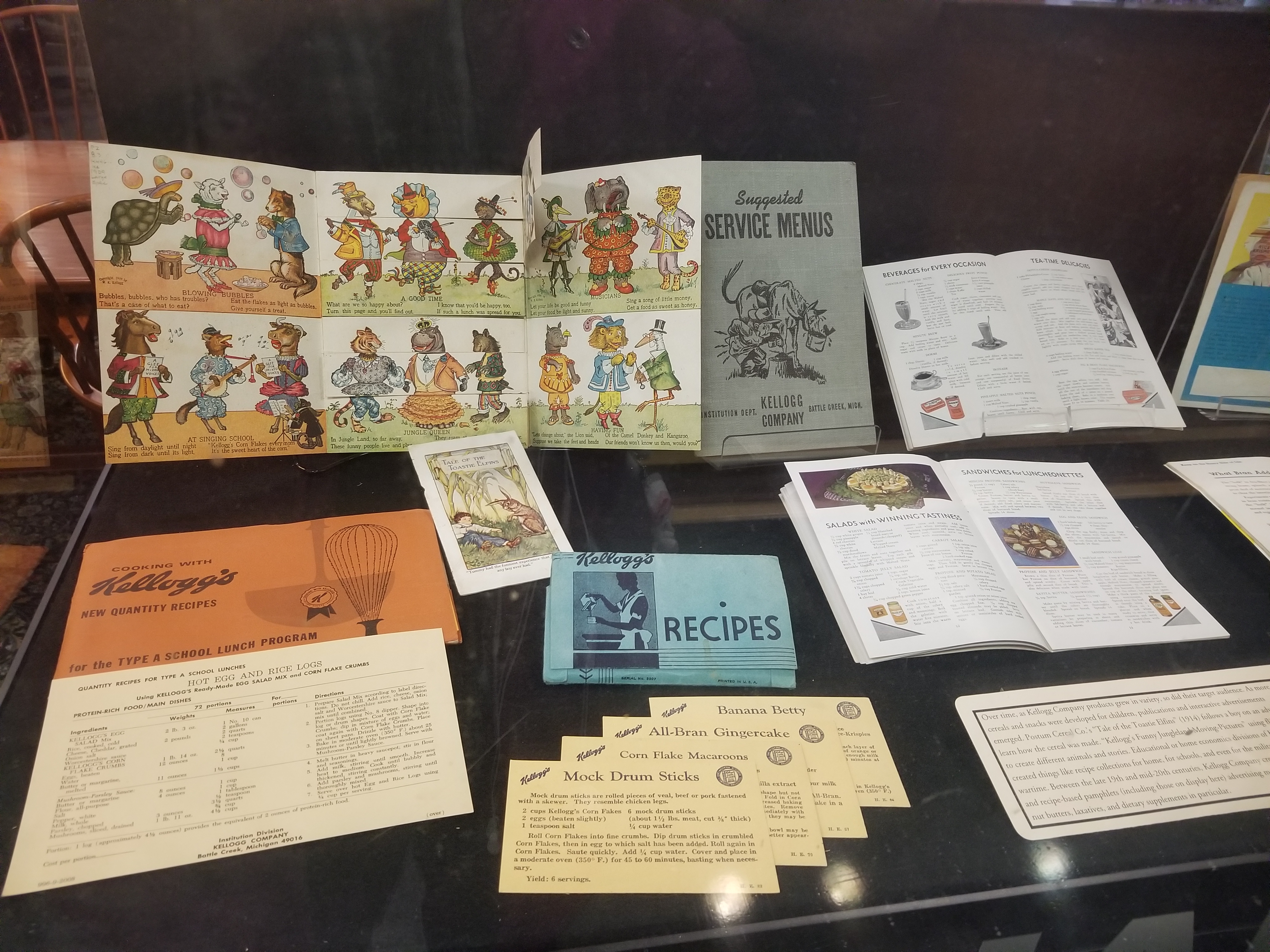
Between the late 19th and mid-20th centuries, the Kellogg Company and the Battle Creek Food Company (started by John to promote foods and supplements after the split between the brothers) created endless product- and recipe-based pamphlets advertising meat substitutes, cereals, nut butters, laxatives, and dietary supplements in particular. John Kelloggs beliefs included a hearty disdain for both tea and coffee. He considered caffeine, like tobacco and alcohol, to be a poison, going so far as to link all of them to moral deficiencies. Whether or not W. K. shared his brothers views (very likely), by the early 20th century, the Kellogg Company began producing Kaffee-Hag, a low caffeine coffee substitute. (John seemed to be against this alternative, too, and he wrote that [n]ature has supplied us with pure water, with a great variety of fruit juices and wholesome and harmless flavors quite sufficient to meet all our needs.) Some years earlier, in 1895, Postum Cereal Co. had already launched their coffee alternative, Postum.
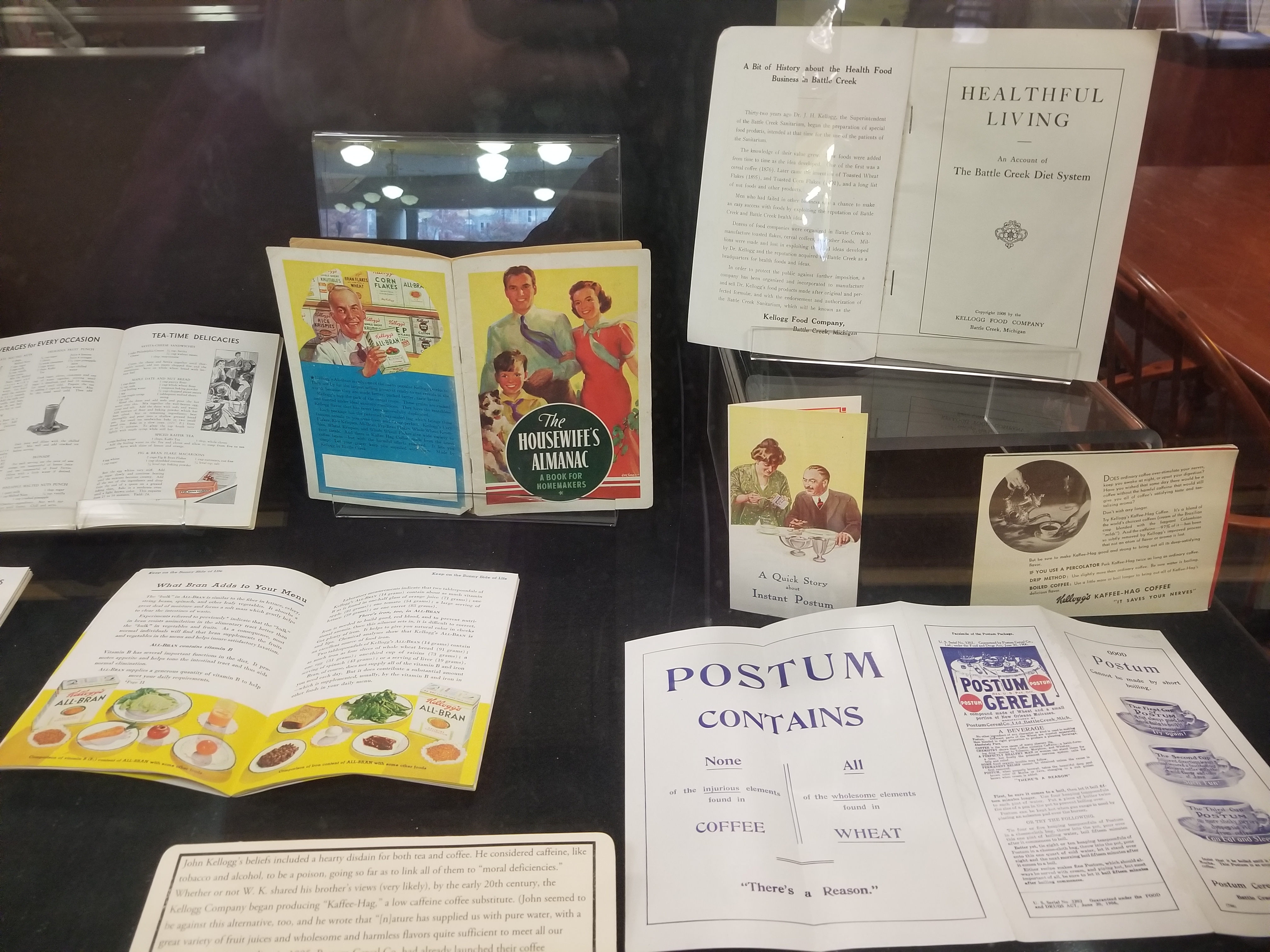
I’ve previously written about the Kelloggs’ (John, his wife Ella, and his brother W. K.) on our food history blog, so if you’d like to delve a little deeper that’s a good place to start. That series has links to digitized books, other readings on this fascinating (and sometimes controversial) family, and more images.
- The Kellogg Family “Business,” Part I
- The Kellogg Family “Business,” Part II
- The Kellogg Family “Business,” Part III
- New Pamphlet Round-Up #3! (Contains Battle Creek Food Company pamphlet)
- Veggie Goodness, Part I (Contains some information about John and W. K.’s meat substitute, protose)
And if all of this doesn’t satisfy your curiosity about the Kelloggs, C. W. Post, early breakfast cereal, or Battle Creek, feel free to visit us and learn more. There is a lot more to John Kellogg’s theories, inventions, and methods at the Battle Creek Sanitarium; to the early days of breakfast cereals; to corporate and family competition; and to the history of food advertising! We’ll be here and we’d love to share!
Holding the Light: April 16th Remembrance Exhibits on display April 8-18, 2019

“Holding the Light,” is one of two exhibits that will be displayed on the second floor commons in Virginia Tech’s Newman Library as the university observes its 2019 Day of Remembrance.
The exhibit, on display Thursday, April 8 through Tuesday April 18, is a collaboration between the University Libraries and Student Engagement and Campus Life and honors those lost and injured on April 16, 2007. It features items of condolence from around the nation and world.
Among the artifacts on display will be an eight-pointed star quilt from St. Labre Indian School in Ashland, Montana, large banners signed by people in Seoul, South Korea, a work of calligraphy from Japan based on the Buddhist Heart Sutra, and a painting by students at Rappahannock County High School. The exhibit will also include items from the State University of New York Morrisville, Florida State University, Virginia Tech Graduate Arts Council, Hillel, Living Buddhism, and Unitarian Universalist Congregation of the New River Valley.

A display in the windows of Special Collections on the 1st floor of Newman Library will also reflect the “Holding the Light” theme. Most of the items on display were either left at the Drillfield memorial in the aftermath of April 16th or from vigils at other places in remembrance of the victims and in honor of the survivors.
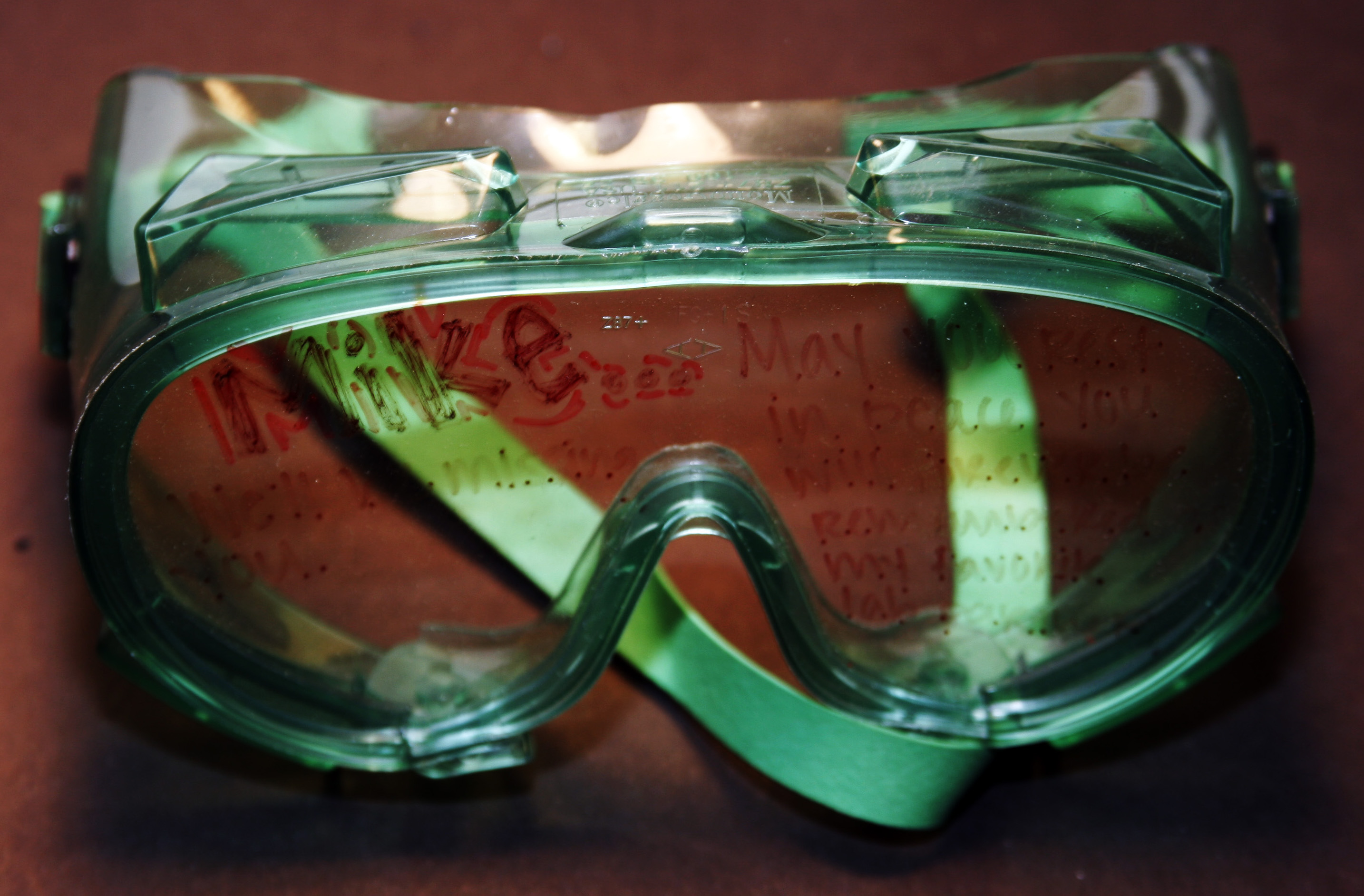
The second exhibit, “A Community of Learners, a Legacy of Achievement,” will feature photographs of each of the 32 victims and a selection of books that reflect their individual disciplines and interests.
In addition to these two exhibits, a small garden space for quiet reflection outside of Squires Student Center’s Old Dominion Ballroom will be available to the community. The garden features a large inscribed rock received from Itawamba Community College in Fulton, Mississippi, and stones from previous April 16 Perspective Gallery Exhibitions. Itawamba Community College planted a dogwood tree in honor of the victims, and this garden also includes a dogwood tree.

For more information on the 2019 Day of Remembrance, please visit the We Remember website.
Expressions of Remembrance: April 16th 10th anniversary exhibits
As part of Virginia Techs annual observance of its Day of Remembrance, condolence items and artifacts received by the university in the days that followed April 16, 2007, will be displayed at several locations across campus. The displays are among several “Expressions of Remembrance” that will be located in Newman Library, Squires Student Center, Moss Arts Center, and Holtzman Alumni Center; they are free and open to the public.
Each year, in observance of the Day of Remembrance, University Libraries at Virginia Tech displays materials from the April 16 Condolence Archives and invites the community to reflect and remember.
Below is a list and photos of exhibits all around campus. For more on each, please see the press release and the We Remember website.
Sending You All Our Love
The exhibit will include materials received from other colleges and universities, as well as some of the large white boards and signs created on the Drillfield the week of April 16, 2007. Additional items include flags, t-shirts, and condolence books, and a quilt from the Feminist Majority Leadership Alliance at State University of New York College at New Paltz. The exhibit title came from one of the quilt squares, each of which was made by a SUNY student.
This display can be seen April 8-16 in the Old Dominion Ball Room in Squires Student Center.
Remembering Those Lost
Artifacts include flags flown over the Statue of Liberty and at Tikrit Air Academy in Iraq by soldiers during Operation Iraqi Freedom; Farham Aboussalis painting Ceremonial Eternity; Carol Davis 32 hand-decorated eggs; Marilyn Rogges painting of a child releasing a red balloon; a KoKeshi Doll from the U.S. Navy Fleet Activities, Yokosuka, Japan; and some of the paper cranes received.
This display will be held April 8-16 at Newman Library Special Collections (first floor). Part of the exhibit is in the windows of Special Collections onto the cafe, open during library hours. A second portion of the exhibit is inside Special Collections, open Monday-Friday, 8am-5pm.
A Community of Learners, a Legacy of Achievement
A selection of books will be displayed to honor of the students and faculty lost on April 16, 2007.
This display will be held April 8-16 at Newman Library Learning Commons.
Communities of Caring
A digital exhibit featuring community expressions of support from the April 16 Condolence Archives.
This display is available online at http://digitalsc.lib.vt.edu/exhibits/show/april16/introduction.
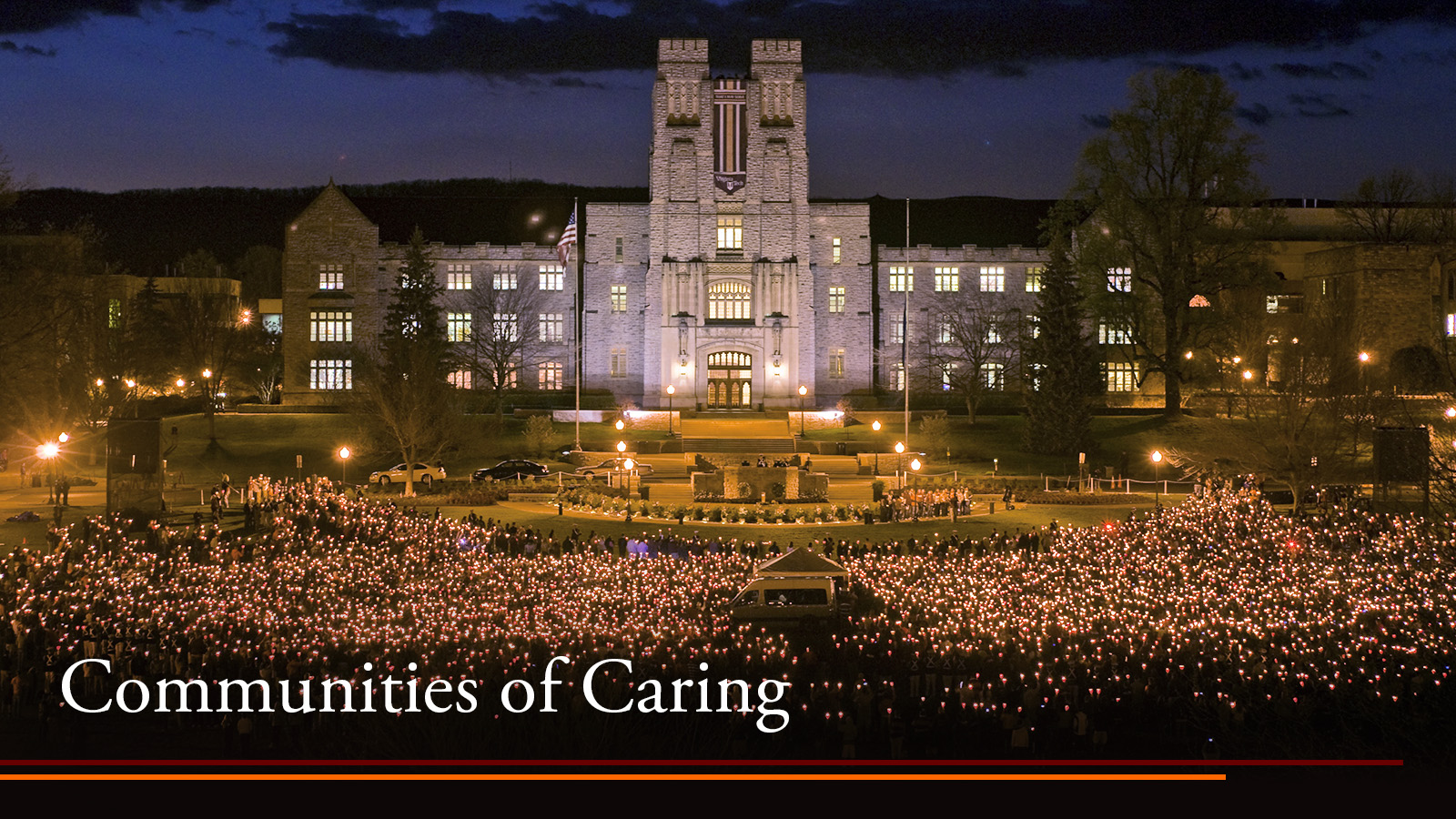
April 16 Condolence Archive display
Items include cards and letters written to police and first responders; a display of the badges of police units who came to help Virginia Tech; Cheryl Thompsons painting, Remember the 32; condolence books; quilted squares from Union Village United Methodist Church; black marble laserworks by David Cunningham, and April 17th Hokies United by Miss Prices second grade class from Riverlawn Elementary, Fairlawn, Virginia.
This display will be held April 12-May 3 at the Holtzman Alumni Center.
Passages
A quiet, contemplative space for remembrance and reflection, this display will include prayer flags from the Virginia Tech Graduate Arts Council, Hillel, Living Buddhism, and Unitarian Universalist Congregation of the New River Valley and photographs from the community.
This display will be held April 12-16 at the Miles C. Horton Jr. Gallery and Sherwood P. Quillen 71 Reception Gallery in Moss Arts Center.
In Support of the Veterans in Society NEH Summer Institute

For months, co-directors Jim Dubinsky of the English Department and Bruce Pencek of the Library, along with Heidi Nobles have been working to plan and seeking to provide for every detail necessary to make this three-week long NEH-supported Summer Institute for College and University Teachers a reality. This past Monday (the 11th) was the first day in a schedule that will have the 25 extraordinarily accomplished participants from all over the country in Blacksburg this week and in D.C. next week before returning to Blacksburg for the third and final week of the program.
The official name of the Institute is “Veterans in Society: Ambiguities and Representations.” The impressive list of faculty include Jonathan Shay, author of Achilles in Vietnam: Combat Trauma and the Undoing of Character and Odysseus in America: Combat Trauma and the Trials of Homecoming. Among his other accomplishments, Shay has served as the Chair of Ethics, Leadership, and Personnel Policy in the office of the U.S. Army Deputy Chief of Staff for Personnel and, in 2007, received a MacArthur fellowship for his work on trauma and the moral injuries of war. Jim Marten is past president of the Society of Civil War Historians, author many books, including Sing Not War: Civil War Veterans in Gilded Age America and the award-winning The Children’s Civil War. Donna Musil is a documentary filmmaker, writer and activist, whose film, Brats: Our Journey Home will be shown as part of a three-show film series that is open to the public. More about that in a moment. Actually, these are just three of the stellar faculty that are participating in the Institute along with Tech’s own Paul Quigley, Director of the Virginia Center for Civil War Studies and James I. Robertson, Jr. Associate Professor of Civil War History; Edward Fox, Professor of Computer Science; and David Cline, also from the History Dept. and who specializes in 20th century U.S. social movements, oral history, and public history. You get the idea . . . and I’ve left all kinds of folks out. For a complete list, see the Institute’s terrific website.
So, what is it that all these fine folks have come to Virginia Tech to discuss and study? Broadly speaking, they are defining the dynamic that may be leading to the emergence of a new interdisciplinary field, that of Veterans Studies. More specifically, the topics range widely, from the ways in which classical literature may play a part in understanding and assisting veterans to the role commemoration and monument building play in cultural memory and the process of reconciliation following war; from the ways in which stories of military service can be captured in oral history to a consideration of the unique perspectives offered by women veterans; from asking, “Who is a veteran?” and considering the social status of veterans to the effects of war on military children and the ways the voices of veterans emerge in music and literature . . . and everything in between and beyond. The reality is that the fact and aftermath of military service define threads that run through every culture, across the generations, and have an impact on the most significant aspects of life and society. Through the seminars, presentations, and activities listed on the Institute’s syllabus, the participants will seek to investigate these and other questions, while defining the beginnings of individual research projects.
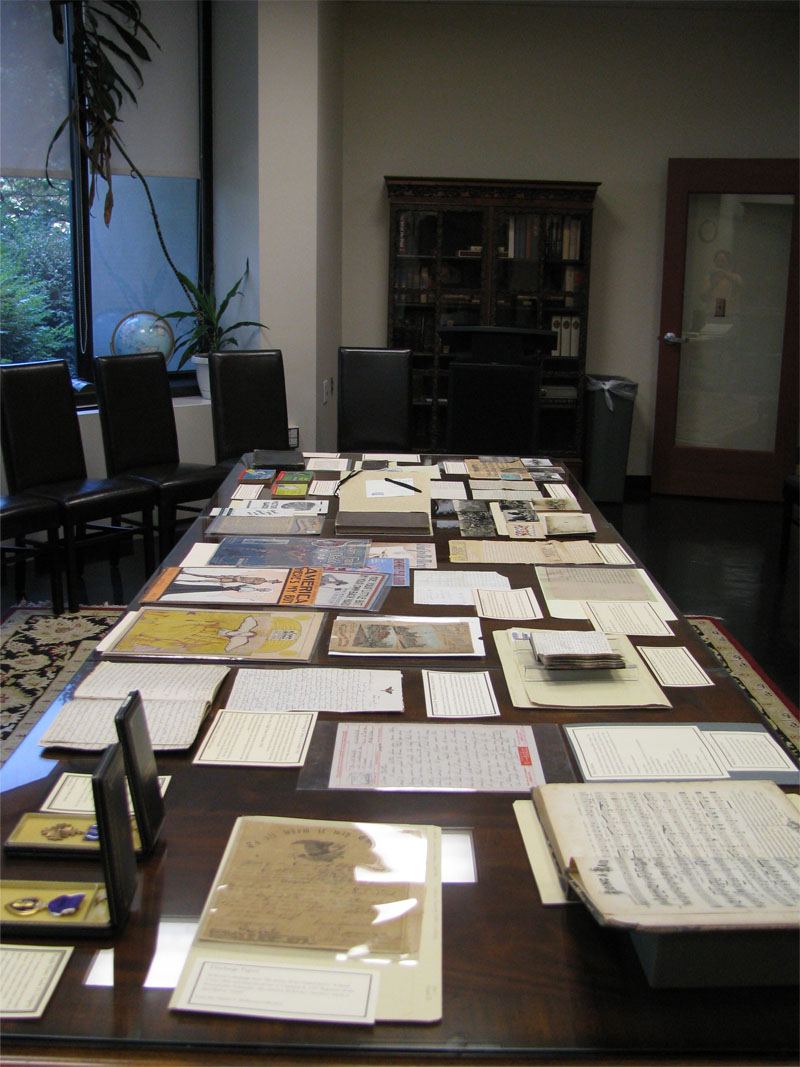
On their second full day in Blacksburg, the members of the Institute had an opportunity to hear about collections of primary sources that may be of interest to them at Special Collections. We set up a display of a few documents and other items and, after a brief introduction, made that exhibit available to them, and to the library community for much of the week. While some of the materials have been displayed before, there were several items that have not been exhibited in recent memory.
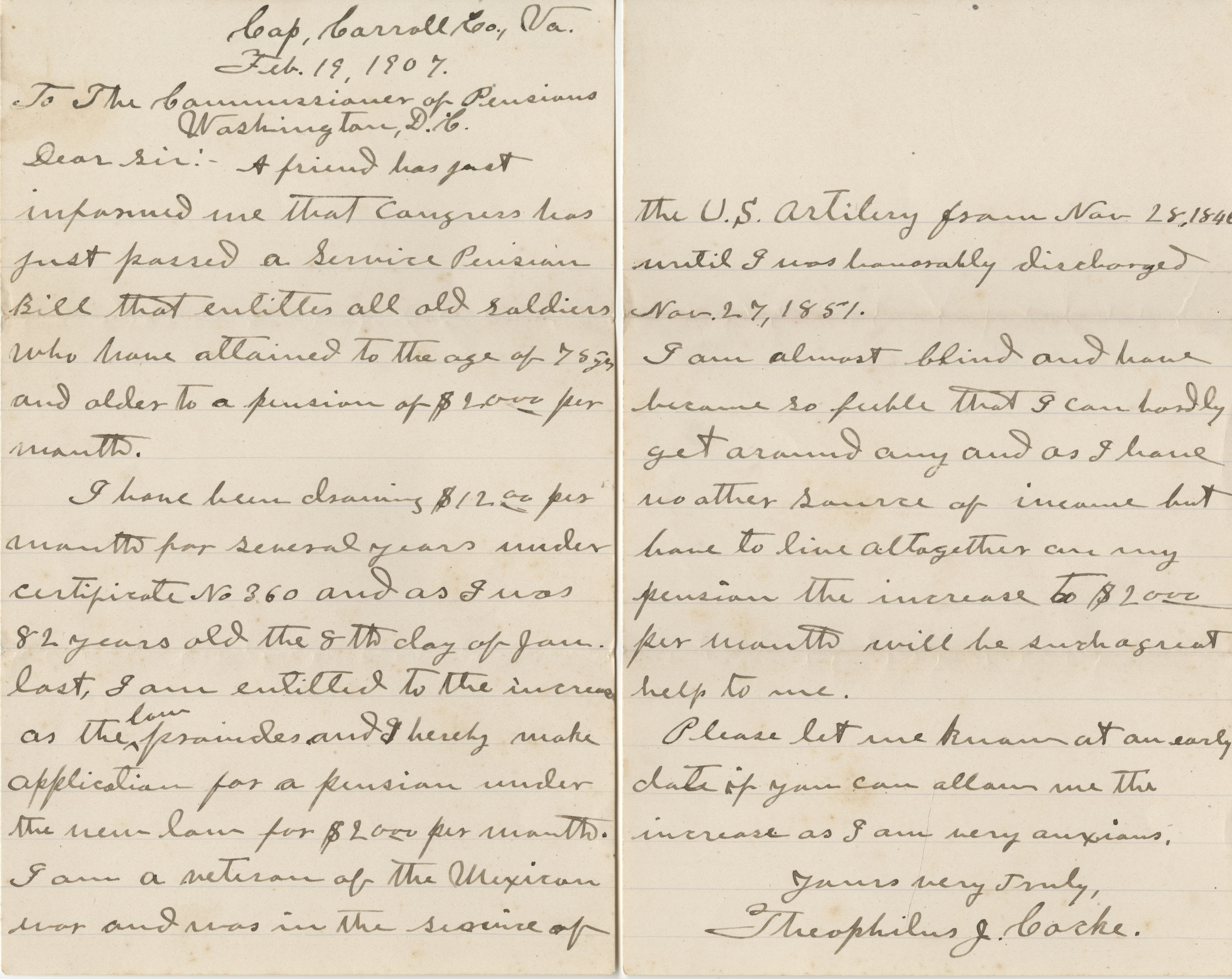
For example, to the right is a scan of a letter written in 1907 by Theophilus Cocke of Carroll County, Virginia. Mr. Cocke was a veteran of the Mexican War (!) writing about the provisions of a new pension bill that would raise his allotment from $12 per month to $20.
In a letter written from Kansas in June 1865, H. E. Norton complained that veteran members of his Michigan Brigade were due to be mustered out following the end of the Civil War, but were instead sent west. He writes, “[I]t is Generally Believed that the Michigan Brigade was Basely sold by the Governor of the State of Michigan for we could never have been transfered to this Dept. if he had not consented to it.” Norton ended up in Nebraska Territory. Extended tours are, apparently, nothing new.
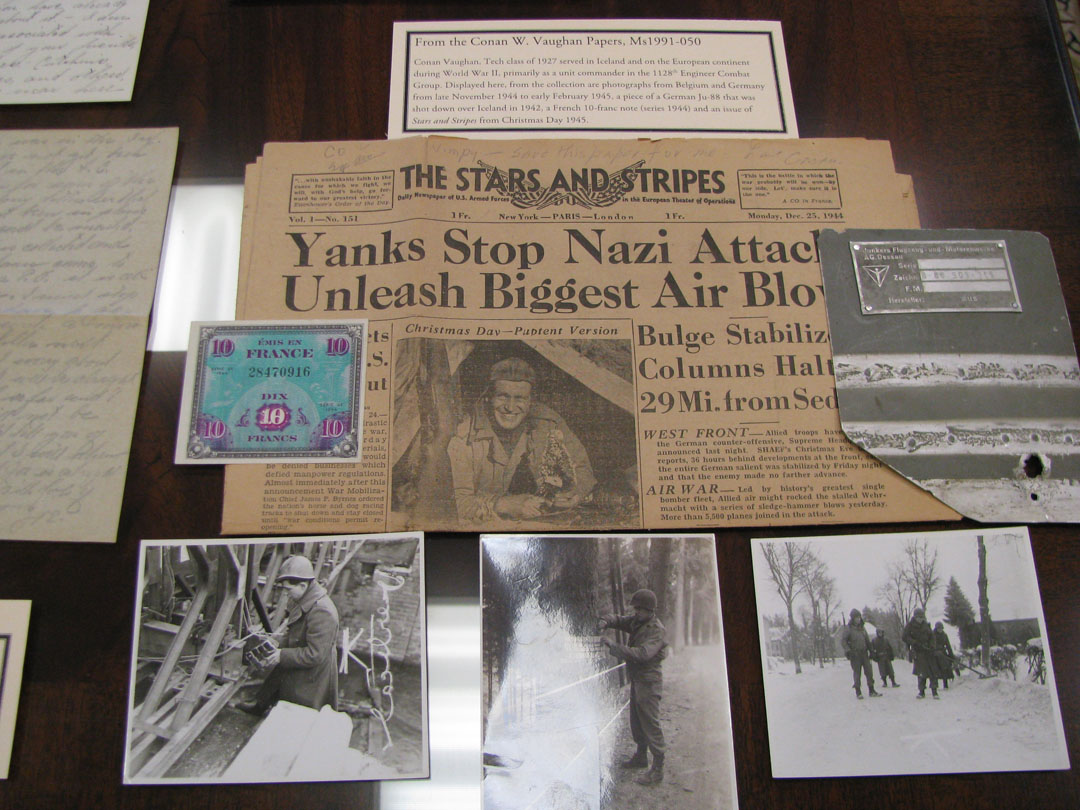
Once in Washington, the Summer Institute participants will spend a day at the Library of Congress and visit Arlington National Cemetery. They’ll talk about the LC’s Veterans History Project and stop at the Confederate memorial, Arlington House, and the U.S. Colored Troops graves. On the way back to Blacksburg, they’ll stop at the D-Day Memorial in Bedford.
Back in town, there will be more seminars, more opportunity to explore topics of interest, and to discuss ideas with the other participants. More time to check out primary sources.
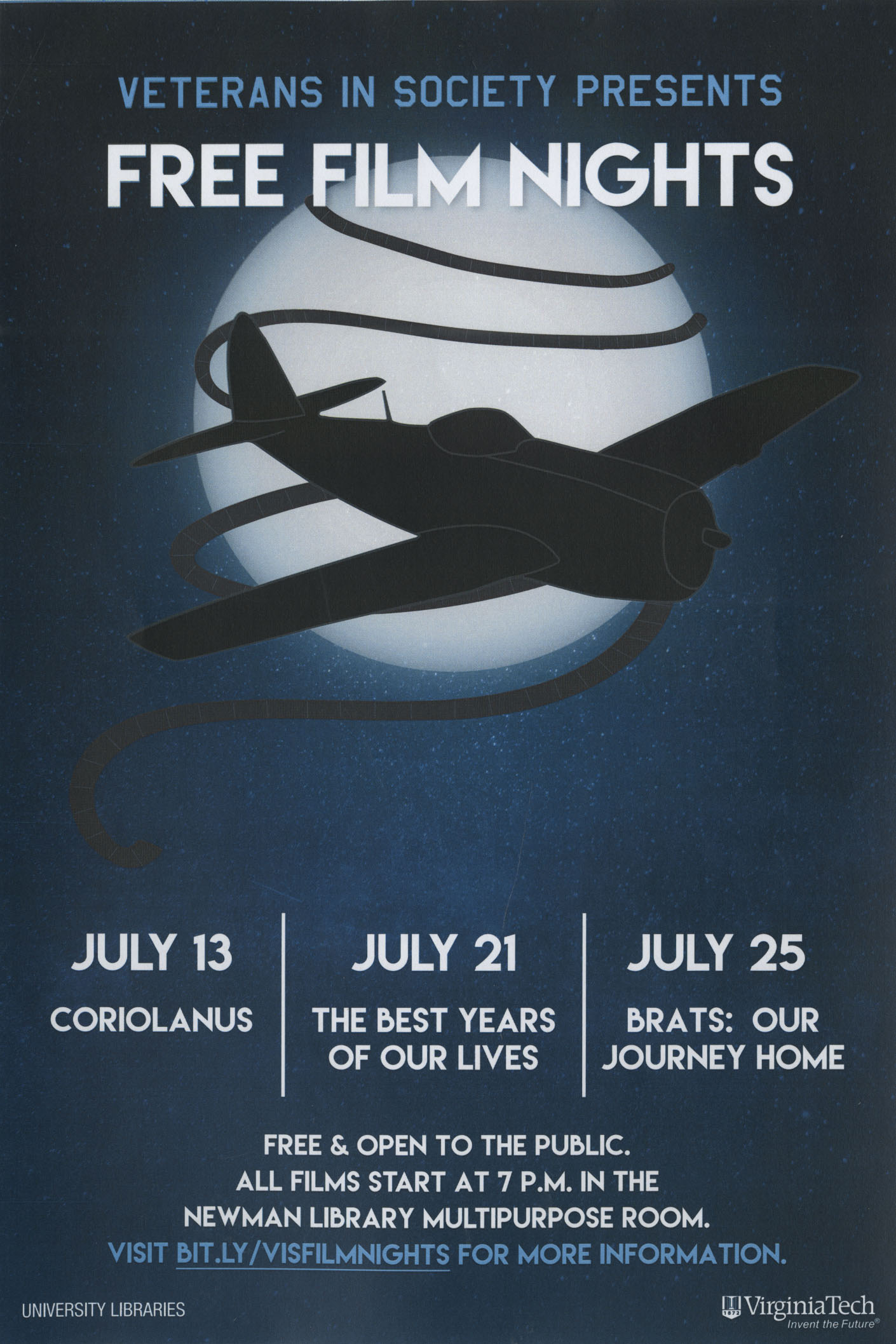
There is also a public component to all of this. The Institute is sponsoring a Free Movie Night. The showing of Coriolanus has already gone, but on July 21st they will be showing The Best Years of Their Lives, a terrific, Oscar-winning movie about returning World War II vets, and on July 25th will be a showing of Brats: Our Journey Home, the documentary mentioned above, with writer and director Donna Musil on hand. These shows begin at 7PM in the MultiPurpose Room on the first floor of Newman Library. Again, the public is invited and admission is free!
Words of Comfort: An exhibit of letters from around the world in the April 16th Condolence Archives
Things have been busy in the University Archives of Special Collections this month, with two exhibits going up this and next week. The first is the memorial exhibit honoring the memory of the victims and survivors of the tragic day of April 16, 2007. Every year we commemorate that day with an exhibit of items from the April 16th Condolence Archives. Please read the press release below to find out more about this year’s event.
The second is an update to the Virginia Tech Alumni Association’s (VTAA) Alumni Museum, with whom Special Collections has worked for over a decade to provide university memorabilia for display. Several archivists and students have been selecting items to update the current display, which will be installed next week. There is no end date for the display of these items, as we plan to continue working with the VTAA for years to come. Also, if you are attending next weekend’s Black Alumni Reunion, you will get to see several additional photographs from the university archives of many pioneering Black female students and alumnae at Virginia Tech, in honor of the 50th anniversary of the first six Black women to attend the university in 1966: Linda (Adams) Hoyle, Jackie (Butler) Blackwell, Linda (Edmonds) Turner, Freddie Hairston, Marguerite Laurette (Harper) Scott, and Chiquita Hudson. You can learn more about them at The Black Women at Virginia Tech History Project.
Day of Remembrance display in Newman Library shares words of comfort and hope
Following April 16, 2007, schools, fellow universities, children, community and religious groups, businesses, and other individuals from around the world sent words of comfort and hope to Virginia Tech. These cards, letters, signs, and other handwritten items expressed the world’s condolences and gave Virginia Tech a global community of support.
This week, on April 15-16, many of these items will be on display in the Multipurpose Room on the first floor of Newman Library at 560 Drillfield Drive in Blacksburg. The exhibit, “Words of Comfort: An exhibit of letters from around the world in the April 16th Condolence Archives,” is free and open to the public, and will be on display from 9 a.m. to 4 p.m. each day.
These items represent over 40 countries and every continent, showing the outpouring of support from around the globe. Selected items on display include:
- Letters and gifts from students in China;
- A photograph of a woman standing at the Amundsen-Scott South Pole Station sign in Antarctica with a “My heart is with VT” sign;
- A poster from a children’s charity group in India;
- Letters and drawings from children in Korea;
- A plaque from a tree planting in Israel;
- Letters from students and university administrators in Nigeria;
- Poems from individuals in the United States;
- Letters from government officials and ambassadors from across the globe.
The materials are part of the Virginia Tech April 16, 2007 Condolence Archives of the University Libraries.
Campus visitors also left symbols of comfort and signs of support at memorials around Virginia Tech, which were displayed on campus for several months before being gathered and inventoried under the direction of the University Archivist. Together, the collection consists of more than 89,000 materials available through Special Collections in Newman Library.
In the summer of 2007, many items were digitally photographed for preservation and to share with the world. A large portion of the Condolence Archives of the University Libraries is now publicly available online.
The upcoming exhibit is organized and curated by LM Rozema, processing and special projects archivist for the University Libraries Special Collections, and Robin Boucher, arts program director for Student Engagement and Campus Life.
Free parking is available on weekends at the Squires Student Center and Architecture Annex lots along Otey Street. Before 5 p.m. on weekdays, a valid Virginia Tech parking pass is required to park in these lots. Find more parking information online, or call 540-231-3200.
If you are an individual with a disability and desire an accommodation, please contact LM Rozema at 540-231-9215 during regular business hours prior to the event.
For more information and other expressions of remembrance, please visit the We Remember site.
Breaking News: You can follow us on twitter, @VT_SCUA!
Recently, our graduate student Rebecca asked about our twitter account – the question being why aren’t we on twitter yet?! Thanks to her prompting, we now are – check us out at @VT_SCUA!
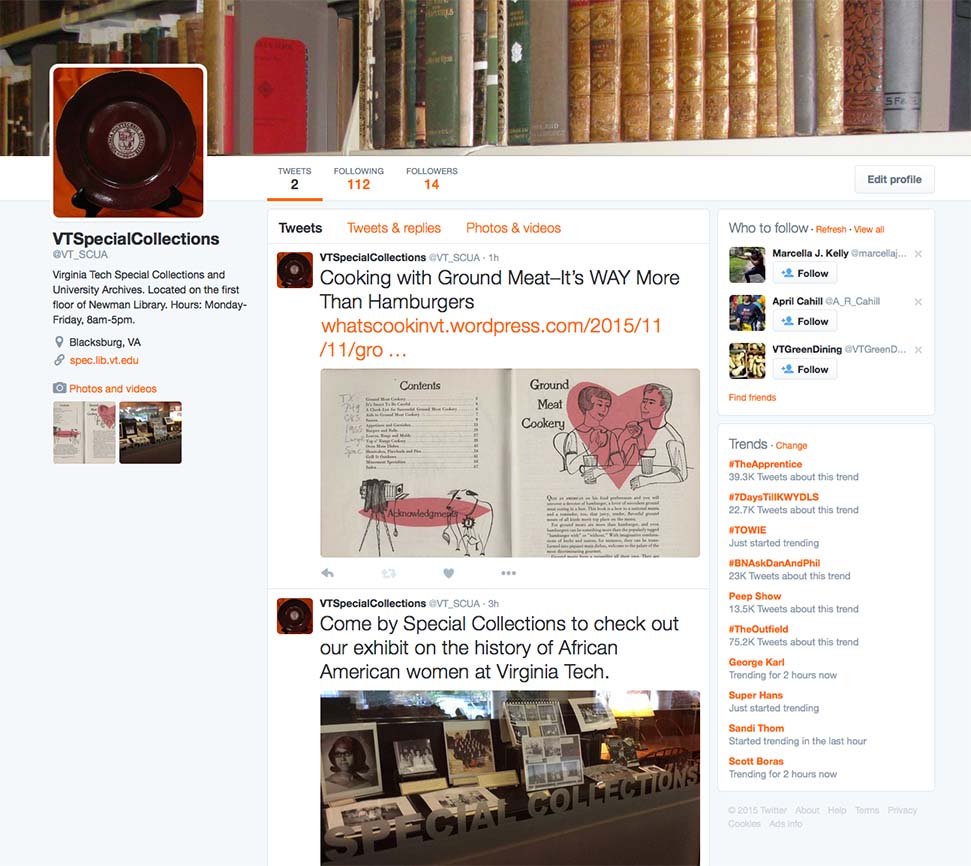
Our first post you will notice is about the exhibit currently on display in our reading room windows about the history of African American female students and student groups at Virginia Tech. And guess what….one of our student volunteers, Alexis, came up with the idea and put it together!
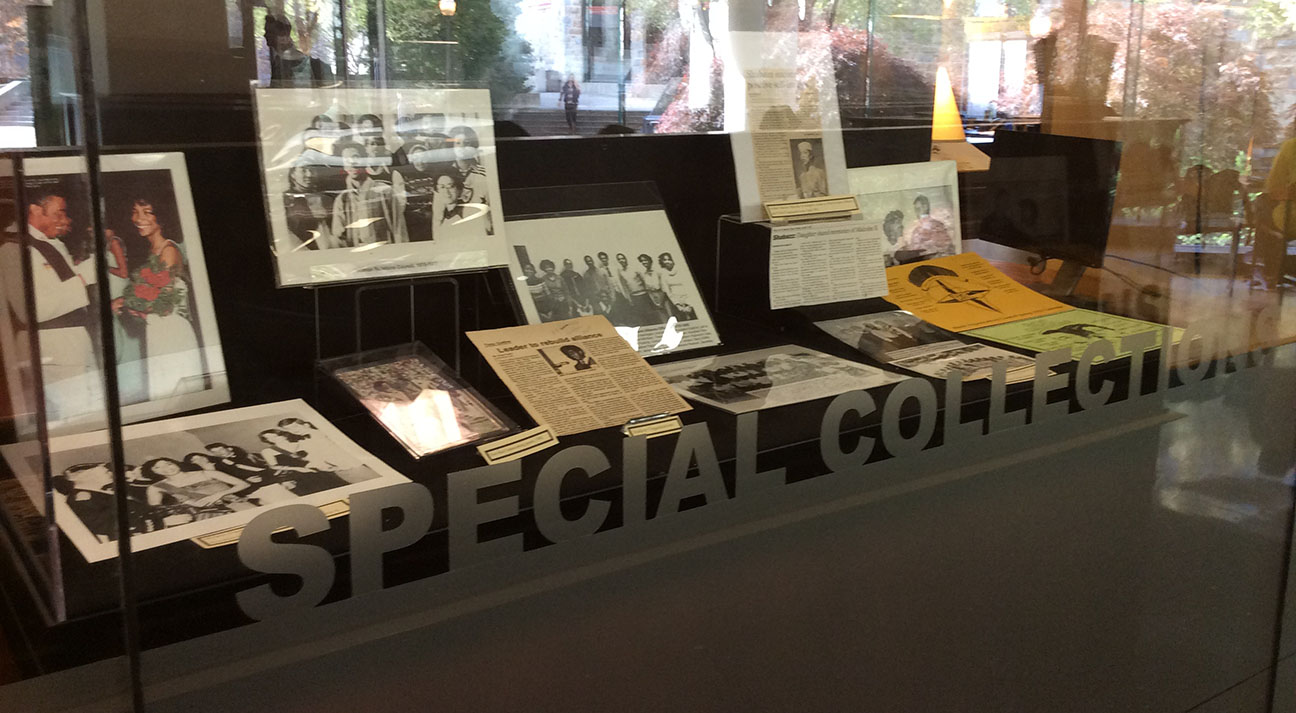
With millions of users on Twitter, it’s a great way to stay current with different Virginia Tech departments and other libraries. Also, we hope the website will encourage our users to engage with us by asking questions, sharing their ideas, or notifying us of relevant stories and news. Because of its nature – being only 140 characters per tweet, we’ll be able (we hope) to share with our followers and others a bit more frequently than we are able to just via our blogs. Some tweets to look for from us include photos of neat items from our collections; announcements of new finding aids, new exhibits, or digital exhibits; upcoming events; and new blog posts on either this blog or our food and drink blog, What’s Cookin’ @ Special Collections?!
We hope that you will enjoy this new way to interact with us at @VT_SCUA!

